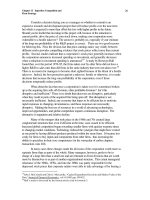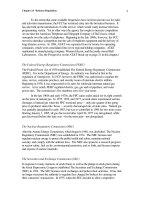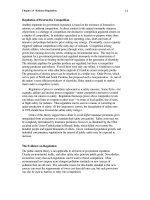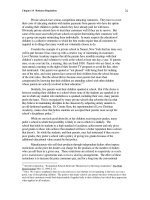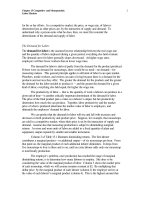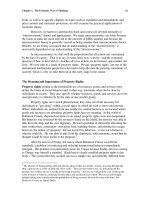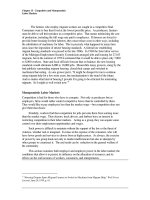MicroEconomics chap003
Bạn đang xem bản rút gọn của tài liệu. Xem và tải ngay bản đầy đủ của tài liệu tại đây (247.26 KB, 20 trang )
Chapter 3: Marginal Analysis
for Optimal Decision
McGraw-Hill/Irwin
Copyright © 2011 by the McGraw-Hill Companies, Inc. All rights reserved.
Optimization
• An optimization problem involves the
specification of three things:
• Objective function to be maximized or
minimized
• Activities or choice variables that determine
the value of the objective function
• Any constraints that may restrict the values of
the choice variables
3-2
Optimization
• Maximization problem
• An optimization problem that involves
maximizing the objective function
• Minimization problem
• An optimization problem that involves
minimizing the objective function
3-3
Optimization
• Unconstrained optimization
• An optimization problem in which the decision
maker can choose the level of activity from an
unrestricted set of values
• Constrained optimization
• An optimization problem in which the decision
maker chooses values for the choice variables
from a restricted set of values
3-4
Choice Variables
• Choice variables determine the value of
the objective function
• Continuous variables
• Discrete variables
3-5
Choice Variables
• Continuous variables
• Can choose from uninterrupted span of
variables
• Discrete variables
• Must choose from a span of variables that is
interrupted by gaps
3-6
Net Benefit
• Net Benefit (NB)
• Difference between total benefit (TB) and total
cost (TC) for the activity
• NB = TB – TC
• Optimal level of the activity (A*) is the level
that maximizes net benefit
3-7
Optimal Level of Activity
(Figure 3.1)
TC
Total beneft and total cost
(dollars)
4,000
D
•
•D’
3,000
B
2,310
2,000
1,085
•
C
•
1,000
• B’
G
•
F
•
NB* =
$1,225
•C’
0
200
TB
A
350 = A*
600 700
1,000
Net beneft
(dollars)
Level of
Panel A – Total benefit and total costactivity
curves
M
1,22
1,00
5
0
600
0
•c’’
•
•
d’’
200
Panel B – Net benefit curve
350 = A*
Level of
activity
600
A
f’’
•
1,000
NB
3-8
Marginal Benefit & Marginal Cost
• Marginal benefit (MB)
• Change in total benefit (TB) caused by an
incremental change in the level of the activity
• Marginal cost (MC)
• Change in total cost (TC) caused by an
incremental change in the level of the activity
3-9
Marginal Benefit & Marginal Cost
Change in total benefit ∆TB
MB =
=
Change in activity
∆A
Change in total benefit ∆TC
MC =
=
Change in activity
∆A
3-10
Relating Marginals to Totals
• Marginal variables measure rates of
change in corresponding total variables
• Marginal benefit & marginal cost are also
slopes of total benefit & total cost curves,
respectively
3-11
Relating Marginals to Totals
(Figure 3.2)
TC
Total beneft and total cost
(dollars)
4,000
G
•
100 F
320
3,000
100
•B
520
100
2,000
640
•C
•
B’
1,000
C’
•
•D
D’•
•
TB
820
100
520
100
340
A
100
0
200
350 = A*
600
Marginal beneft and
marginal cost (dollars)
Level of
Panel A – Measuring slopes along TB activity
and TC
8
c (200, $6.40)
6
5.2
0
4
2
•
800
1,000
MC (= slope of TC)
•d’ (600, $8.20)
b
•
•c’ (200, $3.40)
d (600, $3.20)
•
MB (= slope of TB)
g
0
200
Panel B – Marginals give slopes of
totals
350 = A*
Level of
activity
600
800
•
1,000
A
3-12
Using Marginal Analysis to Find
Optimal Activity Levels
• If marginal benefit > marginal cost
• Activity should be increased to reach highest net
benefit
• If marginal cost > marginal benefit
• Activity should be decreased to reach highest net
benefit
3-13
Using Marginal Analysis to Find
Optimal Activity Levels
• Optimal level of activity
• When no further increases in net benefit are
possible
• Occurs when MB = MC
3-14
Using Marginal Analysis to Find A*
(Figure 3.3)
MB = MC
Net beneft
(dollars)
MB > MC
100
300
0
•
c’’
200
MB < MC
M
•
100
•
d’’
350 = A*
500
600
A
800
NB
1,00
0
Level of activity
3-15
Unconstrained Maximization with
Discrete Choice Variables
• Increase activity if MB > MC
• Decrease activity if MB < MC
• Optimal level of activity
• Last level for which MB exceeds MC
3-16
Irrelevance of Sunk, Fixed, and
Average Costs
• Sunk costs
• Previously paid & cannot be recovered
• Fixed costs
• Constant & must be paid no matter the level of
activity
• Average (or unit) costs
• Computed by dividing total cost by the number of
units of the activity
3-17
Irrelevance of Sunk, Fixed, and
Average Costs
• These costs do not affect marginal cost & are
irrelevant for optimal decisions
3-18
Constrained Optimization
• The ratio MB/P represents the additional
benefit per additional dollar spent on the
activity
• Ratios of marginal benefits to prices of
various activities are used to allocate a
fixed number of dollars among activities
3-19
Constrained Optimization
• To maximize or minimize an objective
function subject to a constraint
• Ratios of the marginal benefit to price must
be equal for all activities
• Constraint must be met
MBA MBB
MBZ
=
= ... =
PA
PB
PZ
3-20

